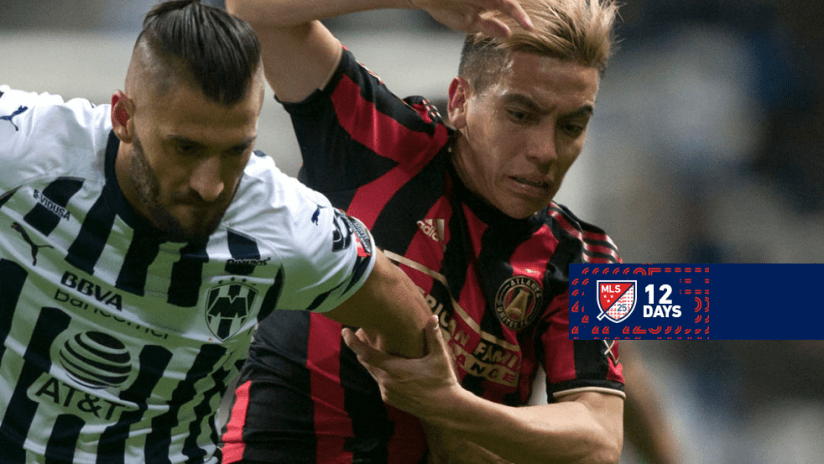EDITOR'S NOTE: Before you know it, February 29 will be here. That's the kickoff to the 25th season in Major League Soccer history and we're getting you ready for the 2020 campaign with the stories, personalities and questions that will leave their mark on the season to come.
“One swallow does not a summer make,” goes the ancient proverb. No one player’s choice or transfer transaction can define a trend, even one that’s now taken a clear shape like the pronounced spike in the northbound flow of the burgeoning traffic between MLS and Liga MX.
But something, somehow, feels different about Rodolfo Pizarro’s move to Inter Miami.
It’s the league’s most recent, and apparently priciest, major acquisition of Liga MX talent this winter, a deal that reportedly involved Miami triggering a $12 million release clause just to start the process, to say nothing of what are surely lofty Designated Player wages. And Pizarro has been convinced to leave CF Monterrey, one of the richest and most successful clubs in the hemisphere and reigning Liga MX and Concacaf champions, to jump aboard an expansion ship just before its maiden voyage.
This transaction is also notable for what it does NOT entail. The versatile playmaker is a prominent member of the Mexico national team, but has landed in one of the relatively few metropolitan areas in the US where El Tri are not the most popular team among the Latinx community. He hasn’t been acquired to sell jerseys.
Having just marked his 26th birthday, he’s in the prime of his career. He’s already got three Liga MX titles, two Concacaf Champions League trophies and a Gold Cup on his resume. He’s not trying to break into his national team; he aims to stay there, take on an even bigger role under Tata Martino and eventually vault across the Atlantic to try his hand in Europe. He says MLS is a better springboard to do it from.
Successfully making this case to Pizarro, and Lucas Cavallini and Edison Flores and Alan Pulido and Lucas Zelarayan and others like them, is one arrow of MLS’s three-pronged attack on the lead Liga MX has long retained in the race for North American supremacy. Recruiting top players northward – not just from Mexico but from the talent-rich markets of South America, where the two leagues are increasingly competing for the same caliber of signings – is essential to continued, much less accelerated, growth.
Some see evidence of a sea change unfolding at present. As ESPN’s Tom Marshall recently wrote, “In the past three Liga MX transfer windows, there have been 16 moves from Liga MX to MLS and eight going the other way, turning previous perceptions about transfers between the leagues on their head.” Several of the MLS clubs involved have smashed their own spending records to make it happen.
But that increased spending ambition is only one front, and possibly the most straightforward to enact tangible progress on. There’s the rather substantial matter of making headway in head-to-head competition on the pitch.
MLS has nursed an 11-year ache against Liga MX in Concacaf Champions League. The northern league has never won the region’s top club competition in its modern era, and MLS teams have only reached the tournament’s final on three occasions: Real Salt Lake in 2011, Montreal Impact in 2015 and Toronto FC two years ago.
According to ESPN statistics, Liga MX teams are 28-14-12 vs. MLS opponents in CCL play since 2012. TFC’s run to the 2018 final, where they fell to Chivas Guadalajara on a penalty-kick shootout in agonizing circumstances, highlighted a dramatic improvement that year as MLS teams won three out of their six series vs. Mexican opposition. There was backsliding in the 2019 CCL, however, where MLSers advanced in just one of their five matchups vs. Liga MX foes.
But the year also marked the launch of Leagues Cup, the new summer tournament pitting MLS against Liga MX clubs, and a win for Atlanta United over Club America in the second edition of Campeones Cup, a one-off annual clash between the two nations’ reigning league champions. Both provide further avenues for contention and comparison, and along with CCL serve as objective metrics on MLS’s challenge of Liga MX.
The to-do list, in brief:
- Get over the hump and finally win CCL
- Send a team to the Leagues Cup final
- Win Campeones Cup again
Even with three events instead of just one, these are limited windows for proving progress towards parity. It’s a tricky business to set hard benchmarks in the context of knockout tournaments, where myriad factors can contribute to outcomes. But if MLS really wants to tell a story of closing the gap in 2020, there’s no getting around it.
Nothing talks like Ws.













